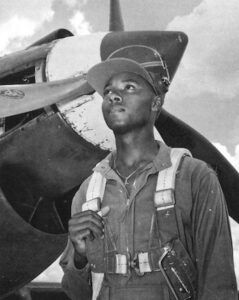
Mac Ross
*Mac Ross was born on this date in 1912. He was a Black U.S. Army Air Force officer and combat fighter pilot.
Mac Ross was born in rural Dallas County near Selma, Alabama, the son of Eddie Samuel "Sam" Ross and Willie B. Collins Ross. He had eight siblings: Eddie, Sammy, Jerry, Arthur, Suritha, Geniva, Mattie, and Willa. In the late 1920s, his father, mother, and nine children moved to Ohio in part because he didn't want his sons to be raised where they could be lynched.
Young Ross graduated from Roosevelt High School and then attended West Virginia State University, graduating in 1940 with a degree in mechanical arts, and was a member of the Alpha Phi Alpha fraternity. He also worked at the Iron Works GHR Foundry in Dayton. On June 3, 1943, Ross married Abbie Voorhies, a night shift nurse at the Tuskegee Airfield. Ross's alma mater, West Virginia State College, had a Civilian Pilot Training Program (CPTP) created by the Civil Aeronautics Authority (CAA) in 1939 to increase the number of active pilots in America in response to the ongoing war in Europe. It cost $15 a week to attend, which was paid by Ross's father. The college competed with Tuskegee and four other historically black colleges and universities to institute a commercial pilot program for African American CPTP graduates.
Ultimately, the federal government selected the Tuskegee Institute as the official commercial pilot program for African American pilots. West Virginia State College officials nominated two alumni for the program: Ross and George S. Roberts, a 1938 West Virginia State College graduate. Ross was admitted into the U.S. Army Air Corps Tuskegee Aviation Cadet training program's inaugural class on July 19, 1941. On March 7, 1942, only five cadets successfully graduated from the program, becoming Tuskegee Airmen. Those receiving their wings: 2nd Lt. Ross, Captain Benjamin O. Davis Jr., 2nd Lt. Charles DeBow, 2nd Lt. Lemuel R. Custis, and 2nd Lt. George S. Roberts. Known as Class 42-C-SE, they were the first African-American U.S. Army Air Corps pilots. On May 26, 1942, Ross was promoted to Squadron Commander of the 332nd Fighter Group's 100th Squadron, with Lt George Knox and SE-42-A classmate Charles DeBow as adjutants. On March 27, 1943, his Squadron transferred to Mt Clemens, Michigan. He commanded the Squadron in additional extensive and intensive training at Selfridge and Oscoda Army Airfield. Ross flew over 50 combat missions in the European Theater during World War II.
On July 10, 1944, Ross died in an aircraft accident. A few days earlier, he had been relieved as group operations officer. The reasons for his relief are unclear; according to one source, he did not "click well" with his commanding officer, Benjamin O. Davis Jr., while another source states Davis felt experience was essential for an operations officer. He replaced Ross with "LT Alfonsa W. Davis, a pilot with two years of combat experience as operations officer." Ross is interred at the Sicily-Rome American Cemetery and Memorial, Plot J, Row 15, Grave 70, near Nettuno, Città Metropolitana di Roma Capitale, Lazio, Italy.
Legacy
According to author Charles E. Francis, Ross was reticent and one of the most conscientious of his group. According to his widow, Abbie Voorhies DeVerges, he had a quiet, confident manner and a positive outlook. "He loved people. He seemed like an all-around guy," she said. On June 27, 1989, the U.S. Postal Service dedicated the Mac Ross Memorial Philatelic Room in Dayton, Ohio, in honor of Ross. A plaque honoring Ross is displayed at the Dayton Post Office on East 5th Street. The University of California, Riverside, maintains the papers of Ross's wife, Abbie. The collection comprises photographs of Ross, Abbie, and other Tuskegee Airmen and nurses, Abbie's military separation records, correspondence, news clippings, and items from the dedication of the philatelic room in Dayton.